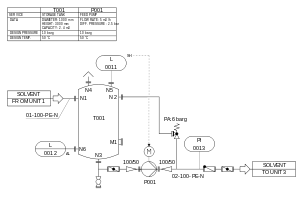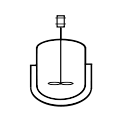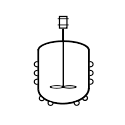Piping and instrumentation diagram

A piping and instrumentation diagram/drawing (P&ID) is a diagram in the process industry which shows the piping of the process flow together with the installed equipment and instrumentation.
Contents and function
A piping and instrumentation diagram/drawing (P&ID) is defined by the Institute of Instrumentation and Control as follows:
- A diagram which shows the interconnection of process equipment and the instrumentation used to control the process. In the process industry, a standard set of symbols is used to prepare drawings of processes. The instrument symbols used in these drawings are generally based on International Society of Automation (ISA) Standard S5. 1.
- The primary schematic drawing used for laying out a process control installation.
P&IDs play a significant role in the maintenance and modification of the process that it describes. It is critical to demonstrate the physical sequence of equipment and systems, as well as how these systems connect. During the design stage, the diagram also provides the basis for the development of system control schemes, allowing for further safety and operational investigations, such as a Hazard and operability study commonly pronounced as HAZOP.
For processing facilities, it is a pictorial representation of
- Key piping and instrument details
- Control and shutdown schemes
- Safety and regulatory requirements
- Basic start up and operational information
List of P&ID items
- Instrumentation and designations
- Mechanical equipment with names and numbers
- All valves and their identifications
- Process piping, sizes and identification
- Miscellanea - vents, drains, special fittings, sampling lines, reducers, increasers and swaggers
- Permanent start-up and flush lines
- Flow directions
- Interconnections references
- Control inputs and outputs, interlocks
- Interfaces for class changes
- Computer control system
- Identification of components and subsystems delivered by
Identification and reference designation
Based on Standard ANSI/ISA S5.1 and ISO 14617-6, the P&ID is used for the identification of measurements within the process. The identifications consist of up to 5 letters. The first identification letter is for the measured value, the second is a modifier, 3rd indicates passive/readout function, 4th - active/output function, and the 5th is the function modifier.
| Letter | Column 1 (Measured value) | Column 2 (Modifier) | Column 3 (Readout/passive function) | Column 4 (Output/active function) | Column 5 (Function modifier) |
| A | Analysis | Alarm | |||
| B | Burner, combustion | User choice | User choice | User choice | |
| C | User's choice (usually conductivity) | Control | Close | ||
| D | User's choice (usually density) | Difference | Deviation | ||
| E | Voltage | Sensor | |||
| F | Flow rate | Ratio | |||
| G | User's choice (usually gaging/gauging) | Gas | Glass/gauge/viewing | ||
| H | Hand | High | |||
| I | Current | Indicate | |||
| J | Power | Scan | |||
| K | Time, time schedule | Time rate of change | Control station | ||
| L | Level | Light | Low | ||
| M | User's choice | Middle / intermediate | |||
| N | User's choice (usually torque) | User choice | User choice | User choice | |
| O | User's choice | Orifice | Open | ||
| P | Pressure | Point/test connection | |||
| Q | Quantity | Totalize/integrate | Totalize/integrate | ||
| R | Radiation | Record | Run | ||
| S | Speed, frequency | Switch | Stop | ||
| T | Temperature | Transmit | |||
| U | Multivariable | Multifunction | Multifunction | ||
| V | Vibration, mechanical analysis | Valve or damper | |||
| W | Weight, force | Well or probe | |||
| X | User's choice (usually on-off valve as XV) | X-axis | Accessory devices, unclassified | Unclassified | Unclassified |
| Y | Event, state, presence | Y-axis | Auxiliary devices | ||
| Z | Position, dimension | Z-axis or Safety | Actuator, driver or unclassified final control element | ||
For reference designation of any equipment in industrial systems the standard IEC 61346 (Industrial systems, installations and equipment and industrial products — Structuring principles and reference designations) can be applied. For the function Measurement the reference designator B is used, followed by the above listed letter for the measured variable.
For reference designation of any equipment in a power station the KKS Power Plant Classification System can be applied.
Symbols of chemical apparatus and equipment
Below are listed some symbols of chemical apparatus and equipment normally used in a P&ID, according to ISO 10628 and ISO 14617.
 |
Pipe |  |
Thermally insulated pipe |  |
Jacketed pipe |  |
Cooled or heated pipe |
 |
Jacketed mixing vessel (autoclave) |  |
Half pipe mixing vessel |  |
Pressurized horizontal vessel |  |
Pressurized vertical vessel |
 |
Pump |  |
Vacuum pump or compressor |  |
Bag |  |
Gas bottle |
 |
Fan |  |
Axial fan |  |
Radial fan |  |
Dryer |
 |
Packed column |  |
Tray column |  |
Furnace |  |
Cooling tower |
 |
Heat exchanger |  |
Heat exchanger |  |
Cooler |  |
Plate & frame heat exchanger |
 |
Double pipe heat exchanger |  |
Fixed straight tubes heat exchanger |  |
U shaped tubes heat exchanger |  |
Spiral heat exchanger |
| |
Covered gas vent |  |
Curved gas vent |  |
(Air) filter |  |
Funnel |
 |
Steam trap |  |
Viewing glass |  |
Pressure reducing valve |  |
Flexible pipe |
 |
Valve |  |
Control valve |  |
Manual valve |  |
Back draft damper |
 |
Needle valve |  |
Butterfly valve |  |
Diaphragm valve |  |
Ball valve |
See also
External links
- Commons:Category:Chemical engineering symbols - A list of P&ID symbols in SVG format
- PID symbol legend - A list of P&ID symbols